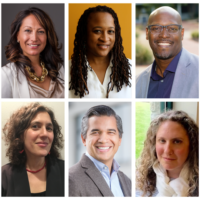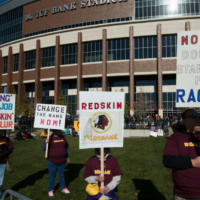
The most popular blog posts of 2018
Last week, we recapped many of NCRP’s activities and accomplishments from 2018. One thing we didn’t mention: In 2018, we added 96 posts to NCRP’s blog.
And, if you follow NCRP on Facebook, LinkedIn or Twitter, you’ve probably noticed that in late December we counted down our Top 10 most-viewed blog posts of the year.
If you missed any or all of those posts, here is the entire list of the 10 most-viewed posts of the year:
 10. Building community power: A philanthropic strategy and an end goal by Caitlin Duffy
10. Building community power: A philanthropic strategy and an end goal by Caitlin Duffy
What does it mean for funders to build power?
As more and more grantmakers embark on or deepen journeys to embed values of equity, diversity and inclusion into their work, how can we incorporate a power-building frame to measure meaningful progress on equity?
 9. Asking the right questions: How philanthropy can make a difference in challenging times by Aaron Dorfman
9. Asking the right questions: How philanthropy can make a difference in challenging times by Aaron Dorfman
NCRP president and CEO Aaron Dorfman delivered the closing keynote at the Yale Philanthropy Conference on February 23, 2018:
“You are all here, we are all here, because we want to use our philanthropy to make the world a better place.
“If we’re going to be successful in doing that, we have got to ask ourselves the right questions. These are challenging times in which we live. By asking ourselves the right questions, the hard questions, we can make a real difference with our philanthropy on issues that truly matter. I’m going to put forward five questions today that I think will help us be effective in these challenging times.”

Photo courtesy of Funders’ Collaborative on Youth Organizing.
8. Beyond the walkout: A call to philanthropy to invest in youth-led social change by Mónica Córdova
We must invest in organized youth efforts to cultivate lasting change. To get to scale and sustain their work, they need the support of philanthropy. The moment is now. Resources must follow.
 7. Anti-Semitism and Anti-Black racism both advance white supremacy by Jeanné Isler and Timi Gerson
7. Anti-Semitism and Anti-Black racism both advance white supremacy by Jeanné Isler and Timi Gerson
Leverage your power to deepen your analysis and educate others about the connection between anti-Semitism and anti-Black racism.
Instead of excluding groups who are mostly values aligned, but may be ignorant about this connection, make space to wrestle with hard history towards joint action. It is our hope that with these terrible massacres, we are motivated to search our blind spots and expose them to the light.
 6. Leading by example: Addressing racial equity through incremental change by Nathan Boon
6. Leading by example: Addressing racial equity through incremental change by Nathan Boon
To “lead by example” is a fundamental principle within philanthropy. However, the power dynamic inherent to the funder-grantee relationship can sometimes lead to a lack of self-reflection or self-discipline among funders. A funder wishing to advance a best practice may require the practice from its grantees but forgo the difficult work of implementing the practice for itself.
 5. Why examining power and privilege is critical to shifting culture in philanthropy by Lisa Ranghelli
5. Why examining power and privilege is critical to shifting culture in philanthropy by Lisa Ranghelli
What does power have to do with equity? How can grantmakers better leverage power to help drive lasting, positive change in our communities?
As the philanthropic sector’s interest in racial equity has grown, there has been limited explicit discussion of the role of power and privilege, which funders must grapple with to truly change inequitable systems.
 4. Why we need to #DisruptPhilanthropyNOW by Lisa Ranghelli
4. Why we need to #DisruptPhilanthropyNOW by Lisa Ranghelli
At NCRP, we joke that we’ve been biting the hand that feeds us for more than 40 years. Yet racial and social justice organizations remain reluctant to apply the same tactics they use with public officials and corporate titans to philanthropy.
Within Our Lifetime (WOL) and Old Money New System Community of Practice (OMNS) are trying to change that with their bold new campaign, #DisruptPhilanthropyNOW.
 3. Announcing Power Moves for consultants! by Caitlin Duffy
3. Announcing Power Moves for consultants! by Caitlin Duffy
In philanthropy, everyone knows that foundation leaders and staff have power. But consultants are another group that can have an outsized impact – often unseen, behind closed doors. In advising grantmaker clients, the best and most influential consultants bring to bear deep expertise and rich experience as community change agents, nonprofit leaders or foundation staff to help funders hone organizational strategies, culture, practices and more.
 2. A humbling (foundation) admission about Indian mascots … and a glimmer of hope for the future by Raymond Foxworth
2. A humbling (foundation) admission about Indian mascots … and a glimmer of hope for the future by Raymond Foxworth
In a May 7 op-ed in USA Today, Dr. Richard Besser, president and CEO of the Robert Wood Johnson Foundation (RWJF), publicly acknowledged changes to the foundation’s annual Sports Award. This annual competitive award is intended to recognize “sports teams, athletes and community-based organizations that use sports to catalyze and sustain changes to make communities healthier places to live, learn, work and play.”
Besser said the foundation would no longer consider award applications from sports teams that denigrate American Indian people. He humbly noted that the foundation – whose mission targets health equity – never considered “the fact that the team names, mascots and misappropriation and mocking of sacred symbols like headdresses do real damage to the health of people across the country.”
 1. Corporate donations to public schools are a poor substitute for government funding by Nick Faber
1. Corporate donations to public schools are a poor substitute for government funding by Nick Faber
Four years ago, the Saint Paul Federation of Teachers (SPFT), along with parents and community members, committed ourselves to ensuring that students in Saint Paul, particularly students of color, receive a quality education.
While we’ve made great strides to improve public education in Saint Paul, there is much more that still needs to be done. Class sizes are still too big; there are not enough nurses, counselors or social workers; and we need to include more schools in programs that have proven effective in disrupting the school-to-prison pipeline, such as restorative practices and teacher home visits.
Peter Haldis is NCRP’s communications manager. Follow @NCRP on Twitter.
Images by Fibonacci Blue, Pedro Ribeiro Simões and Governor Tom Wolf. Used under Creative Commons license.